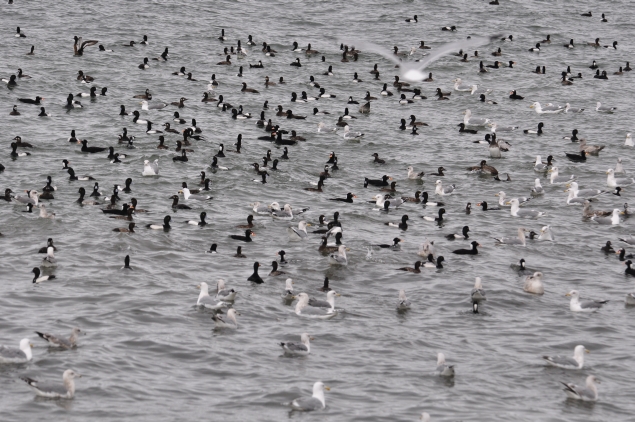The bay area is blessed (cursed??!?!!!?!?!) with an enormous diving duck population in the winter months...some of the state's biggest concentrations of divers are here, if the not the biggest. Mount Tamalpais watches over them, no doubt a knowing and powerful duck god. Miller-Knox Regional Shoreline, Richmond, CA.
Surf Scoters and Greater Scaup. Thousands of ducks convened at Miller-Knox last month to feed on the herring roe that had also brought in enormous numbers of gulls.
Surf Scoters and Greater Scaup. Thousands of ducks convened at Miller-Knox last month to feed on the herring roe that had also brought in enormous numbers of gulls.
Herring runs are fun for ducks and gulls alike. Here they mingle in harmony...the mind reels.
Among the throngs of Surf Scoters was this lone male Black Scoter. Their preference of wintering sites in the state are generally not conducive to photography, so it was nice to finally get some photos of the yellow-knobbed enigma.
Black Scoters are rare, or at most locally uncommon in coastal California...they are probably not overly enigmatic either, although they have been less studied than other sea ducks. Population estimates and trends are imprecise at best.
Among the throngs of Surf Scoters was this lone male Black Scoter. Their preference of wintering sites in the state are generally not conducive to photography, so it was nice to finally get some photos of the yellow-knobbed enigma.
Black Scoters are rare, or at most locally uncommon in coastal California...they are probably not overly enigmatic either, although they have been less studied than other sea ducks. Population estimates and trends are imprecise at best.
Black Scoters of western North America breed entirely in tundra lakes of Alaska; the closest population of breeding eastern birds is in Hudson Bay. I wonder how genetically divergent these birds might be.
It was truly a vulgar display of fowl. The seas seethed and frothed with egg-laden ducks.
A high-density scaup flock scrambles for handouts. Nothing will churn the placid waters of the lake like a bunch of carb-loading ducks. Lake Merritt, Oakland, CA.
Aside from the coots and Canvasbacks, these are almost all Greater Scaup, with one obvious Lesser mixed in. Can you find it? If you can't, the Global Birder Ranking System will note your failure.
Is there a better place than Lake Merritt for Canvasback watching? I have yet to find it.
Red-breasted Mergansers around here are mostly females and young males...older males mostly winter to the north of us. Not sure if this is a young bird or if it's still molting out of eclipse (this was photographed a few months ago).
This Common Goldeneye is going into classic stealth mode, where they swim with their neck extended and head held just above the water. Doesn't seem particularly stealthy to me but they think it works.
Locals will recognize this female Redhead that has been wintering on Lake Merritt for the past several years. The white flecking on her head (a result of leucism, not old age) makes her easy to identify as the same returning bird.













Well, being a lover of the Anus (you know, latin name for duck...), so for my two cents it's not a curse. In fact, it's seems like you even enjoyed yourself out there.
ReplyDeleteIt's certainly cool to see the superlative male Canvasback being all way more awesome than the plebeian Scaup.
Glad you caught that stealthy Goldeneye before it disappeared. We get to see them so poorly around Maricopa. I assumed it was because their numbers are small and they like deep water reservoirs that allow them a fair distance from the shore, but maybe I'm just bad at finding them when they're stealthing it. And here I was all proud that I probably saw the Lesser Scaup in that throng. Oh well.
That Black Scoter is bitchin'. I've only seen a dumpy female on Lake Havasu. The ridiculous Surf Scoter...that's the one I still need.
It's "Anas"! Hahaha...
ReplyDeleteSurf Scoter is the one you need eh? It's pretty hard to see Black Scoter before Surf Scoter, well played.
It's a cruel world indeed.
DeleteP.S. I knew the proper latin...I just couldn't resist Anus ya know?
Love the ducky shots. I'm a HUGE fan of surf scoters, and good to know to keep an eye peeled for the black scoter.
ReplyDeleteIs it me, or do those ducks with the yellow eyes ALL look EXTREMELY over-caffeinated? Yikes!